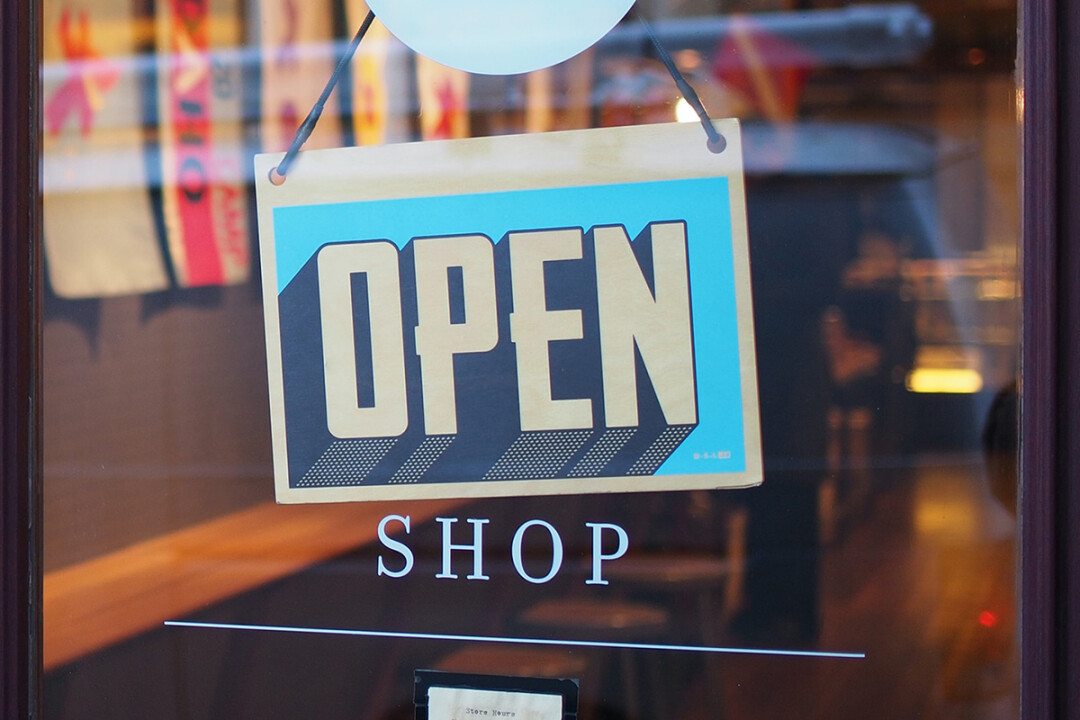As They Re-Open, Wisconsin Businesses Face Challenges, Seek Resources

Western Wisconsin’s only cat café, Tabby’s Catfe, in Menomonie closed for good on May 8 due to hardships brought on by the coronavirus pandemic and state emergency orders, which called for closures of restaurants unless curbside or take-out ordering was made available. A cat café that served great sandwiches and homemade soups in front and offered adoptable cats in back just didn’t fit into that business model. Since they opened three years ago, co-owners Karlyn Davis and Amanda Davis served scores of cat-loving customers and helped 64 cats find their forever homes in partnership with the Dunn County Humane Society. Since they own other businesses, they will continue their relationship with the humane society; however, this business is now gone.
Thirty-five percent of Wisconsin businesses predicted they could close permanently if the shutdown would have continued for three months, according to an online survey by UW-Oshkosh completed by 2,538 businesses in early April. In a follow-up survey in May, 23% of respondents reported they would be out of business if current conditions continued for three months, although 65% said they had already re-opened. (Full survey results using easily understandable visuals are available at uwosh.edu/ccrs/covid-19-survey.)
Thirty-five percent of Wisconsin businesses predicted they could close permanently if the shutdown would have continued for three months, according to an online survey by UW-Oshkosh completed by 2,538 businesses in early April. In a follow-up survey in May, 23% of respondents reported they would be out of business if current conditions continued for three months.
As Gov. Tony Evers has stated, reopening the economy should be more like turning a dial, not flipping a switch, in order to keep the number of COVID-19 cases down and the accompanying curve as flat as possible. Throughout the nation, states, counties, and cities are all adjusting the dial at their own rates – some rapidly, some slowly.
The most fundamental challenge the pandemic has raised is how much are we willing to pay – or more accurately, lose – by shutting down the economy in order to save lives, according to Peter Cappelli, a management professor at the University of Pennsylvania’s Wharton School of Business.
“This sounds like a policy question,” Cappelli wrote in an April 30 column in Human Resources Executive, “but it is also a practical management problem because employers are gearing up for the challenge of bringing employees back to work when we know that doing so, and ending social isolation will increase the risk that more people will get sick and die.”
To determine where businesses in Wisconsin are on the proverbial dial, the previously mentioned survey is being conducted by a partnership including the UW-Oshkosh Center for Customized Research and Services, the Wisconsin Economic Development Corp., and the state’s nine regional economic development organizations.
The self-reported survey is designed to measure the economic hardships and impact of the pandemic on the state’s business community. Small business owners are asked to respond to a specific monthly survey. The ultimate goal is to measure and assess recovery ability and state and federal aid efforts.
A total of 270 businesses in the region served by Momentum West – which encompasses Barron, Clark, Chippewa, Dunn, Eau Claire, Pierce, Pepin, Polk, Rusk, and St. Croix counties – responded to the April survey. They estimated an income loss of $10 million, an inventory loss of $3 million, lost wages and productivity of $1.41 million, and $8 million of other financial impacts. Thirty-three percent predicted they would close if the shutdown lasted three months.
After Evers’ statewide “Safer at Home” order was overturned by the Wisconsin Supreme Court on May 13, many county health departments issued their own orders, while some held back, saying they have no legal ground to enforce the orders. The Eau Claire City-County Health Department issued an updated order on May 18. However, it was scheduled to sunset on May 28.
Also on Monday, May 18, the governor’s office in collaboration with WEDC announced a “We’re All In” campaign. The campaign includes grants worth $2,500 to small businesses with 20 or fewer employees impacted by COVID-19 that have not already received grants from WEDC (businesses will be able to apply for the grants in early June) and grants of $2,000 for ethnically diverse Wisconsin micro-businesses with five or fewer employees that suffered losses due to the pandemic and have not received assistance under with the SB 20/20 program or the Small Business Administration’s Paycheck Protection Program.
There are also a series of guides for businesses looking to implement best practices to keep employees, customers, and communities safe throughout the COVID-19 crisis. They were developed in consultation with a variety of state departments as well as industry leaders and public health experts throughout the state. These can be found on WEDC’s website at wedc.org/reopen-guidelines.
“Are you currently struggling to attract and retain customers and/or staff?” is the theme of a series of free live webinar series launching Wed. May 20 and presented by Linda Pophal of Strategic Communications in collaboration with the Western Dairyland Business Center and the Western Wisconsin Women’s Business Center. Topics to be covered over the eight webinars include telework, remote work, remote customer service, and how to connect with and engage customers in this “new normal” world. Space is limited, and pre-registration is required at successfulbusiness.org.
ONLINE RESOURCES FOR BUSINESS OWNERS
If you are a small business owner struggling to understand what to do and how to do it, here are some online resources that may help:
Chippewa Valley COVID-19 Economic Recovery Task Force
Eau Claire Area Economic Development Corporation—COVID-19 Emergency and Economic Recovery Resources
Wisconsin Small Business Development Center at UW-Eau Claire
Wisconsin General Guide for All Businesses (Best Practices to Reopen):
wedc.org/reopen-guidelines (select “General Guidelines” to download PDF)U.S. Census Bureau COVID-19 Demographic and Economic Resources
The Local Leader’s Toolkit: A Strong Towns Response to the Pandemic Guide
Chippewa Valley Business Community COVID-19 Resource Facebook group




















